
![]()
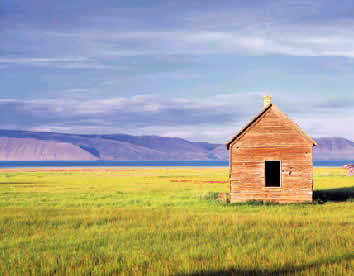 |
In February 2002, images of Utah’s landscape were flashed around the world as some billion-plus viewers worldwide tuned into television to watch the Salt Lake Olympic Winter Games.
Appropriately, the Utah leg of the Olympic torch run began in Arches
National Park, directly under the ancient arm of Delicate Arch, the state’s
most recognizable icon. From there the torch was carried through the spectacular
red rock formations and canyons of southern Utah as a way of showcasing
the natural wonders of the state.
A lover of the solitude offered by the West’s wide, silent spaces,
soaring red cliffs, and cerulean skies, photographer Edwin J. Firmage
BS’83 has attempted to capture that sense of majesty and quietude
in a collaborative effort with his father, Edwin B. Firmage, U of U professor
of law, in a recently published book, Simple Gifts: Photographs and
Reflections from the Landscape.
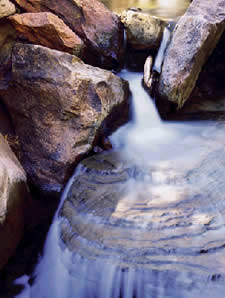 |
Simple Gifts is, however, not just a book; it is a large format (20 x 23.5 inches) collector’s piece sheathed in a hand-bound designer case made of cinnamon bark paper and mahogany leather.
To add to the book’s luster, regional and international writers, poets, and personalities—such as His Holiness, the Fourteenth Dalai Lama, who wrote the book’s introduction—have also contributed. Their essays complement the images by reflecting on the confluence of natural beauty, inner peace, and personal well-being.
Additional contributions come from Gov. Michael Leavitt; former senator Jake Garn; Bernard Weiss, professor of Arabic and Islamic Studies at the U; Thawatchai Puakta, abbot and director, Wat Dhammagunaram Buddhist Temple and Meditation Center in Layton, Utah; Irene Fredericks, director, Sakakawea Film Project; and Chip Ward, noted environmental author and activist, among others.
“Our fellow contributors are not your usual cast of characters in a book about the Western landscape,” Firmage says. “We wanted to sample a broader community of people, who, however much they may differ on the politics of the land, have some connection to it and something interesting to say about its spiritual dimension.
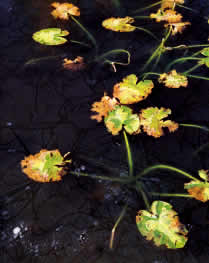 |
“When Dad and I first talked about doing a book,” Firmage continues,
“we thought in terms of a conventional, if nice, coffee-table format.
But the further the project progressed, the more it seemed that this format
wouldn’t do my photography justice. The things that make my prints
unique are their sense of drama and the sharp, rich details that come
from using a large format camera. These things are lost in small prints;
hence, the big book. With the big format also came the necessity of special
binding and materials. What emerged was an art piece designed for collectors
and corporate or institutional buyers looking for a special thank-you
for clients and donors.”
Firmage’s big, fine art prints—trademarked as “watercolor
photographs”—are the signature product of his company, firmageditions,
which he founded in 1998 with his brother, Joe ex’88, who shares
Ed’s passion for photography. They also share an extensive background
in technological innovation and entrepreneurship, which laid the foundation
for a company that Ed describes as “state of the art in high-end
photography, digital image editing, and fine art printing.”
The advantage of digital printing, he explains, is that it allows greater
artistic control over the final product—being able to selectively
adjust contrast or color, for example. “What artist doesn’t
want more control over how his or her vision is communicated?” says
Firmage. Like other artists, he approaches photography with the idea of
stimulating an emotional response to his work. “Only secondarily,”
he says, “is it a matter of technology and technique,” although,
he quickly adds, “the best art happens when inspired vision and great
technique are seamlessly woven together.”
 |
To that end, he pays particular attention to the tools of his trade, which include a 4 x 5 view camera that takes transparencies 13 times larger than those of a 35 mm camera, thereby capturing more visual information and generating sharper, more detailed prints; a drum scanner with an extraordinary optical resolution (11,000 dpi); a spectrophotometer used in color profiling; and, of course, heavy-duty computer hardware and software that allow him to fine-tune the images until his aesthetic sensibilities are satisfied.
Firmage is quick to point out that even with these tools he cannot create high-quality images when the film source is weak. “There is no digital magic,” he says. “You cannot make good prints from a bad photograph, so the crucial first step is getting a quality original.” Once he has that, he spends days, sometimes weeks, refining an image—adjusting color and contrast, bringing out highlights, removing “dust” and scratches—until he is satisfied with the result.
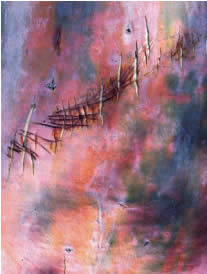 |
The result of the process is a watercolor print from a special Iris printer
that, according to Firmage, “produces fine art prints that rival
serigraphs for longevity and quality.”
After submerging himself in this innovative process, Firmage admits that
he will never be able to return to traditional darkroom techniques. “There
isn’t a single detail in which digital prints, other things being
equal, are not technically superior to conventional darkroom enlargements,”
he says. “They replicate the traditional photographic process but
allow room for much more experimentation and expansion of the creative
process.” And while this creative course may seem complex, the ultimate
aim is pure simplicity.
—Linda Marion is managing editor of Continuum.
| I
believe that inner peace is the key to happiness, but this is not
easy to achieve in the context of the busy lives more and more people
lead today. Stories of the spiritually fulfilled adepts of the past,
whatever tradition they belonged to, tell that many of them retired
periodically to peaceful, isolated places. There are not many accounts
of people who found inner tranquility while dwelling constantly in
the city or town. Therefore, those who seek a degree of inner peace
are traditionally advised to cast off attachment to worldly pleasures
and comforts and to retreat to a quiet and isolated place. —His Holiness, the Fourteenth Dalai Lama, from his introduction to Simple Gifts: Photographs and Reflections from the Landscape |
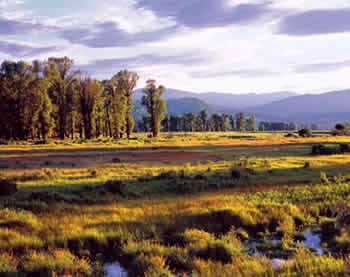 |
